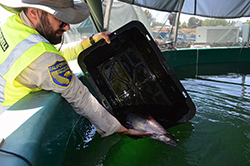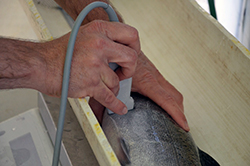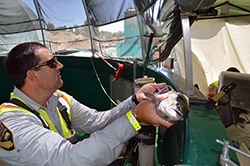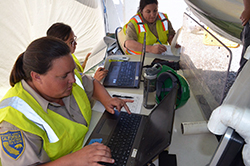On Thursday, May 18, fisheries biologists implanted acoustic transponders into 60 endangered adult spring-run Chinook salmon. The transponders will track their movements and help determine spawning success later this season. The salmon will be released to spawn naturally in the San Joaquin River near Friant over the next three months.
A tiny transponder is placed inside the body cavity of each female salmon. When the fish lay their eggs, the transponders will be expelled, providing scientists with information on when, where and how successful each spawning female is.

After the salmon are tagged, they are returned to a holding pond while the anesthetic wears off.

CDFW scientists electronically identify and perform an ultrasound on each fish in order to assess their pre-spawning condition.

Each salmon in the project received a tiny identity tag that is entered into a database. The computerized system allows biologists to follow individual fish throughout their life cycle.

A team of scientists read, evaluate and record data for each individual salmon.
On Thursday, May 18, fisheries biologists implanted acoustic transponders into 60 endangered adult spring-run Chinook salmon. The transponders will track their movements and help determine spawning success later this season. The salmon will be released to spawn naturally in the San Joaquin River near Friant over the next three months.
Spring-run Chinook have been absent from the river for many decades. Reintroduction is one of multiple strategies biologists are using to reestablish naturally spawning runs of these fish as part of the San Joaquin River Restoration Project. The project – which is jointly coordinated by CDFW, the Bureau of Reclamation, the California Department of Water Resources, the U.S. Fish and Wildlife Service and the National Oceanic and Atmospheric Administration’s National Marine Fisheries Service – is a comprehensive, long-term effort to restore flows to the San Joaquin River from Friant Dam to the confluence of the Merced River and restore a self-sustaining Chinook fishery while reducing or avoiding adverse water supply impacts from restoration flows.
A total of 120 salmon will be implanted and released at two different times. Biologists will track the fish from each release to determine which is most successful. This release strategy provides the hatchery-raised salmon the opportunity to select their own mates, construct redds (a spawning nest in the stream gravel) and spawn naturally.
CDFW photos by Harry Morse